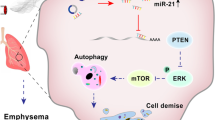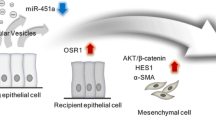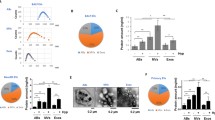Abstract
Cigarette smoke (CS), a complex chemical indoor air pollutant, induces degradation of elastin, resulting in emphysema. Aberrant cross-talk between macrophages and bronchial epithelial cells is essential for the degradation of elastin that contributes to emphysema, in which extracellular vesicles (EVs) play a critical role. The formation of N6-methyladenosine (m6A) is a modification in miRNA processing, but its role in the development of emphysema remains unclear. Here, we established that production of excess mature microRNA-93 (miR-93) in bronchial epithelial cells via enhanced m6A modification was mediated by overexpressed methyltransferase-like 3 (METTL3) induced by CS. Mature miR-93 was transferred from bronchial epithelial cells into macrophages by EVs. In macrophages, miR-93 activated the JNK pathway by targeting dual-specificity phosphatase 2 (DUSP2), which elevated the levels of matrix metalloproteinase 9 (MMP9) and matrix metalloproteinase 12 (MMP12) and induced elastin degradation, leading to emphysema. These results demonstrate that METTL3-mediated formation of EV miR-93, facilitated by m6A, is implicated in the aberrant cross-talk of epithelium–macrophages, indicating that this process is involved in the smoking-related emphysema. EV miR-93 may use as a novel risk biomarker for CS-induced emphysema.
Graphical abstract










Similar content being viewed by others
References
Agusti A, Hogg JC. Update on the pathogenesis of chronic obstructive pulmonary disease. N Engl J Med. 2019;381(13):1248–56. https://doi.org/10.1056/NEJMra1900475.
Alarcon CR, Lee H, Goodarzi H, Halberg N, Tavazoie SF. N6-methyladenosine marks primary microRNAs for processing. Nature. 2015;519(7544):482–5. https://doi.org/10.1038/nature14281.
Brinckerhoff CE, Matrisian LM. Matrix metalloproteinases: a tail of a frog that became a prince. Nat Rev Mol Cell Biol. 2002;3(3):207–14. https://doi.org/10.1038/nrm763.
Cheng M, Sheng L, Gao Q, Xiong Q, Zhang H, Wu M, et al. The m(6)A methyltransferase METTL3 promotes bladder cancer progression via AFF4/NF-kappaB/MYC signaling network. Oncogene. 2019;38(19):3667–80. https://doi.org/10.1038/s41388-019-0683-z.
Dang X, Qu X, Wang W, Liao C, Li Y, Zhang X, et al. Bioinformatic analysis of microRNA and mRNA regulation in peripheral blood mononuclear cells of patients with chronic obstructive pulmonary disease. Respir Res. 2017;18(1):4. https://doi.org/10.1186/s12931-016-0486-5.
De Smet EG, Van Eeckhoutte HP, Avila Cobos F, Blomme E, Verhamme FM, Provoost S, et al. The role of miR-155 in cigarette smoke-induced pulmonary inflammation and COPD. Mucosal Immunol. 2019;13:423–36. https://doi.org/10.1038/s41385-019-0241-6.
Elkington PT, Friedland JS. Matrix metalloproteinases in destructive pulmonary pathology. Thorax. 2006;61(3):259–66. https://doi.org/10.1136/thx.2005.051979.
Foronjy R, Nkyimbeng T, Wallace A, Thankachen J, Okada Y, Lemaitre V, et al. Transgenic expression of matrix metalloproteinase-9 causes adult-onset emphysema in mice associated with the loss of alveolar elastin. Am J Physiol Lung Cell Mol Physiol. 2008;294(6):L1149–57. https://doi.org/10.1152/ajplung.00481.2007.
Gharib SA, Manicone AM, Parks WC. Matrix metalloproteinases in emphysema. Matrix Biol. 2018;73:34–51. https://doi.org/10.1016/j.matbio.2018.01.018.
Gregory RI, Yan KP, Amuthan G, Chendrimada T, Doratotaj B, Cooch N, et al. The microprocessor complex mediates the genesis of microRNAs. Nature. 2004;432(7014):235–40. https://doi.org/10.1038/nature03120.
Gueders MM, Foidart JM, Noel A, Cataldo DD. Matrix metalloproteinases (MMPs) and tissue inhibitors of MMPs in the respiratory tract: potential implications in asthma and other lung diseases. Eur J Pharmacol. 2006;533(1-3):133–44. https://doi.org/10.1016/j.ejphar.2005.12.082.
Hautamaki RD, Kobayashi DK, Senior RM, Shapiro SD. Requirement for macrophage elastase for cigarette smoke-induced emphysema in mice. Science. 1997;277(5334):2002–4. https://doi.org/10.1126/science.277.5334.2002.
He S, Chen D, Hu M, Zhang L, Liu C, Traini D, et al. Bronchial epithelial cell extracellular vesicles ameliorate epithelial-mesenchymal transition in COPD pathogenesis by alleviating M2 macrophage polarization. Nanomed Nanotechnol Biol Med. 2019;18:259–71. https://doi.org/10.1016/j.nano.2019.03.010.
Heinz A. Elastases and elastokines: elastin degradation and its significance in health and disease. Crit Rev Biochem Mol Biol. 2020;55(3):252–73. https://doi.org/10.1080/10409238.2020.1768208.
Hirose I, Kanda A, Noda K, Ishida S. Glucocorticoid receptor inhibits Muller glial galectin-1 expression via DUSP1-dependent and -independent deactivation of AP-1 signalling. J Cell Mol Med. 2019;23(10):6785–96. https://doi.org/10.1111/jcmm.14559.
Hou HH, Wang HC, Cheng SL, Chen YF, Lu KZ, Yu CJ. MMP-12 activates protease-activated receptor-1, upregulates placenta growth factor, and leads to pulmonary emphysema. Am J Physiol Lung Cell Mol Physiol. 2018;315(3):L432–L42. https://doi.org/10.1152/ajplung.00216.2017.
Houghton AM, Hartzell WO, Robbins CS, Gomis-Ruth FX, Shapiro SD. Macrophage elastase kills bacteria within murine macrophages. Nature. 2009;460(7255):637–41. https://doi.org/10.1038/nature08181.
Janoff A, Raju L, Dearing R. Levels of elastase activity in bronchoalveolar lavage fluids of healthy smokers and nonsmokers. Am Rev Respir Dis. 1983;127(5):540–4. https://doi.org/10.1164/arrd.1983.127.5.540.
Jeffrey KL, Brummer T, Rolph MS, Liu SM, Callejas NA, Grumont RJ, et al. Positive regulation of immune cell function and inflammatory responses by phosphatase PAC-1. Nat Immunol. 2006;7(3):274–83. https://doi.org/10.1038/ni1310.
Jeon BN, Song JY, Huh JW, Yang WI, Hur MW. Derepression of matrix metalloproteinase gene transcription and an emphysema-like phenotype in transcription factor Zbtb7c knockout mouse lungs. FEBS Lett. 2019;593(18):2665–74. https://doi.org/10.1002/1873-3468.13501.
Lee JT, Pamir N, Liu NC, Kirk EA, Averill MM, Becker L, et al. Macrophage metalloelastase (MMP12) regulates adipose tissue expansion, insulin sensitivity, and expression of inducible nitric oxide synthase. Endocrinology. 2014;155(9):3409–20. https://doi.org/10.1210/en.2014-1037.
Lv Y, Liu W, Ruan Z, Xu Z, Fu L. Myosin IIA regulated tight junction in oxygen glucose-deprived brain endothelial cells via activation of TLR4/PI3K/Akt/JNK1/2/14-3-3epsilon/NF-kappaB/MMP9 signal transduction pathway. Cell Mol Neurobiol. 2019;39(2):301–19. https://doi.org/10.1007/s10571-019-00654-y.
Ma JZ, Yang F, Zhou CC, Liu F, Yuan JH, Wang F, et al. METTL14 suppresses the metastatic potential of hepatocellular carcinoma by modulating N(6)-methyladenosine-dependent primary MicroRNA processing. Hepatology. 2017;65(2):529–43. https://doi.org/10.1002/hep.28885.
Miao Q, Xu Y, Zhang H, Xu P, Ye J. Cigarette smoke induces ROS mediated autophagy impairment in human corneal epithelial cells. Environ Pollut. 2019;245:389–97. https://doi.org/10.1016/j.envpol.2018.11.028.
Moon HG, Kim SH, Gao J, Quan T, Qin Z, Osorio JC, et al. CCN1 secretion and cleavage regulate the lung epithelial cell functions after cigarette smoke. Am J Physiol Lung Cell Mol Physiol. 2014;307(4):L326–37. https://doi.org/10.1152/ajplung.00102.2014.
Morrow JD, Glass K, Cho MH, Hersh CP, Pinto-Plata V, Celli B, et al. Human lung DNA methylation quantitative trait loci colocalize with chronic obstructive pulmonary disease genome-wide association loci. Am J Respir Crit Care Med. 2018;197(10):1275–84. https://doi.org/10.1164/rccm.201707-1434OC.
Nyunoya T, Mebratu Y, Contreras A, Delgado M, Chand HS, Tesfaigzi Y. Molecular processes that drive cigarette smoke-induced epithelial cell fate of the lung. Am J Respir Cell Mol Biol. 2014;50(3):471–82. https://doi.org/10.1165/rcmb.2013-0348TR.
O’Farrell HE, Yang IA. Extracellular vesicles in chronic obstructive pulmonary disease (COPD). J Thorac Dis. 2019;11(Suppl 17):S2141–S54. https://doi.org/10.21037/jtd.2019.10.16.
Oglesby IK, McElvaney NG, Greene CM. MicroRNAs in inflammatory lung disease--master regulators or target practice? Respir Res. 2010;11:148. https://doi.org/10.1186/1465-9921-11-148.
Rawlinson C, Martin S, Frosina J, Wright C. Chemical characterisation of aerosols emitted by electronic cigarettes using thermal desorption-gas chromatography-time of flight mass spectrometry. J Chromatogr A. 2017;1497:144–54. https://doi.org/10.1016/j.chroma.2017.02.050.
Rosas-Alonso R, Galera R, Sanchez-Pascuala JJ, Casitas R, Burdiel M, Martinez-Ceron E, et al. Hypermethylation of anti-oncogenic microRNA 7 is increased in emphysema patients. Arch Bronconeumol. 2019;56:506–13. https://doi.org/10.1016/j.arbres.2019.10.017.
Schuh K, Pahl A. Inhibition of the MAP kinase ERK protects from lipopolysaccharide-induced lung injury. Biochem Pharmacol. 2009;77(12):1827–34. https://doi.org/10.1016/j.bcp.2009.03.012.
Seimetz M, Parajuli N, Pichl A, Veit F, Kwapiszewska G, Weisel FC, et al. Inducible NOS inhibition reverses tobacco-smoke-induced emphysema and pulmonary hypertension in mice. Cell. 2011;147(2):293–305. https://doi.org/10.1016/j.cell.2011.08.035.
Selman M, Cisneros-Lira J, Gaxiola M, Ramirez R, Kudlacz EM, Mitchell PG, et al. Matrix metalloproteinases inhibition attenuates tobacco smoke-induced emphysema in guinea pigs. Chest. 2003;123(5):1633–41. https://doi.org/10.1378/chest.123.5.1633.
Shibata S, Miyake K, Tateishi T, Yoshikawa S, Yamanishi Y, Miyazaki Y, et al. Basophils trigger emphysema development in a murine model of COPD through IL-4-mediated generation of MMP-12-producing macrophages. Proc Natl Acad Sci U S A. 2018;115(51):13057–62. https://doi.org/10.1073/pnas.1813927115.
Shipley JM, Wesselschmidt RL, Kobayashi DK, Ley TJ, Shapiro SD. Metalloelastase is required for macrophage-mediated proteolysis and matrix invasion in mice. Proc Natl Acad Sci U S A. 1996;93(9):3942–6. https://doi.org/10.1073/pnas.93.9.3942.
Sng JJ, Prazakova S, Thomas PS, Herbert C. MMP-8, MMP-9 and neutrophil elastase in peripheral blood and exhaled breath condensate in COPD. Copd. 2017;14(2):238–44. https://doi.org/10.1080/15412555.2016.1249790.
Son J, Lee SY. Ursonic acid exerts inhibitory effects on matrix metalloproteinases via ERK signaling pathway. Chem Biol Interact. 2019;315:108910. https://doi.org/10.1016/j.cbi.2019.108910.
Vogelmeier CF, Criner GJ, Martinez FJ, Anzueto A, Barnes PJ, Bourbeau J, et al. Global strategy for the diagnosis, management, and prevention of chronic obstructive lung disease 2017 report: GOLD Executive Summary. Eur Respir J. 2017;49(3). https://doi.org/10.1183/13993003.00214-2017.
Wahlgren J, De LKT, Brisslert M, Vaziri Sani F, Telemo E, Sunnerhagen P, et al. Plasma exosomes can deliver exogenous short interfering RNA to monocytes and lymphocytes. Nucleic Acids Res. 2012;40(17):e130. https://doi.org/10.1093/nar/gks463.
Wang J, Ishfaq M, Xu L, Xia C, Chen C, Li J. METTL3/m(6)A/miRNA-873-5p attenuated oxidative stress and apoptosis in colistin-induced kidney injury by modulating Keap1/Nrf2 pathway. Front Pharmacol. 2019;10:517. https://doi.org/10.3389/fphar.2019.00517.
Wu L, Tanimoto A, Murata Y, Fan J, Sasaguri Y, Watanabe T. Induction of human matrix metalloproteinase-12 gene transcriptional activity by GM-CSF requires the AP-1 binding site in human U937 monocytic cells. Biochem Biophys Res Commun. 2001;285(2):300–7. https://doi.org/10.1006/bbrc.2001.5161.
Xu H, Ling M, Xue J, Dai X, Sun Q, Chen C, et al. Exosomal microRNA-21 derived from bronchial epithelial cells is involved in aberrant epithelium-fibroblast cross-talk in COPD induced by cigarette smoking. Theranostics. 2018;8(19):5419–33. https://doi.org/10.7150/thno.27876.
Yang W, Bai J, Liu D, Wang S, Zhao N, Che R, et al. MiR-93-5p up-regulation is involved in non-small cell lung cancer cells proliferation and migration and poor prognosis. Gene. 2018;647:13–20. https://doi.org/10.1016/j.gene.2018.01.024.
Zeke A, Misheva M, Remenyi A, Bogoyevitch MA. JNK signaling: regulation and functions based on complex protein-protein partnerships. Microbiol Mol Biol Rev. 2016;80(3):793–835. https://doi.org/10.1128/MMBR.00043-14.
Zhang J, Bai R, Li M, Ye H, Wu C, Wang C, et al. Excessive miR-25-3p maturation via N(6)-methyladenosine stimulated by cigarette smoke promotes pancreatic cancer progression. Nat Commun. 2019;10(1):1858. https://doi.org/10.1038/s41467-019-09712-x.
Acknowledgements
The authors thank Donald L. Hill (University of Alabama at Birmingham, USA), an experienced, English-speaking scientific editor, for editing.
Materials availability
All the data and materials presented in the current study along with additional files are available from the corresponding author on reasonable request.
Code availability
Not applicable.
Funding
This work was supported by the Natural Science Foundations of China (81973085, 81803276, 81973005), the Top Talent Support Program for young and middle-aged people of Wuxi Health Committee (BJ2020006), and the Priority Academic Program Development of Jiangsu Higher Education Institutions (2019).
Author information
Authors and Affiliations
Contributions
Haibo Xia and Yan Wu designed and wrote the manuscript; Haibo Xia, Yan Wu, and Jing Zhao performed in vivo experiments; Haibo Xia and Jing Zhao performed in vitro experiments; Wenqi li, Lu Lu and Huimin Ma analyzed the data; Tao Bian and Qizhan Liu assisted with the manuscript revision; and Quanyong Xiang and Qizhan Liu supervised the study.
Corresponding authors
Ethics declarations
Ethics approval
All human samples procedures were approved by the Ethics Committee of Wuxi People’s Hospital affiliated with Nanjing Medical University. All animal procedures were reviewed and approved by the Institutional Animal Care and Use Committee at Nanjing Medical University.
Consent for publication
Not applicable.
Conflict of interest
The authors declare no competing interests.
Additional information
Publisher’s note
Springer Nature remains neutral with regard to jurisdictional claims in published maps and institutional affiliations.
Highlights
1. CSE increases levels of METTL3 and miR-93 with a dose-dependent manner in HBE cells.
2. CSE promotes miR-93 maturation via METTL3-mediated m6A modification in HBE cells.
3. CS induces the degradation of elastin in lung tissue due to elevation of MMP9 and MMP12 in macrophages.
4. EV miR-93 mediates the aberrant cross-talk of epithelium–macrophages in CS-induced emphysema.
Supplementary Information
ESM 1
(DOCX 117 kb)
Rights and permissions
About this article
Cite this article
Xia, H., Wu, Y., Zhao, J. et al. The aberrant cross-talk of epithelium–macrophages via METTL3-regulated extracellular vesicle miR-93 in smoking-induced emphysema. Cell Biol Toxicol 38, 167–183 (2022). https://doi.org/10.1007/s10565-021-09585-1
Received:
Accepted:
Published:
Issue Date:
DOI: https://doi.org/10.1007/s10565-021-09585-1




